Spatio-Temporal Extraction of Surface Waterbody and Its Response of Extreme Climate along the Upper Huaihe River
Abstract
:1. Introduction
2. Materials and Methods
2.1. Study Area
2.2. Collection and Preparation of Data
2.2.1. Landsat Images
2.2.2. El Niño/La Niña Data
2.2.3. Rainfall and Temperature Data
2.3. Methodology
2.3.1. Waterbody Extraction Model
2.3.2. Frequency Calculation Model
2.3.3. Water Classification Mapping
3. Results
3.1. Accuracy Evaluation
3.2. Effects of Extreme Climate on Surface Water
3.2.1. Extreme Precipitation, Drought, and El Niño/La Niña
3.2.2. Time-Series Analysis of Climatic Factors and Surface Water
3.2.3. Effect of Climate on the Distribution Pattern of Surface Water
4. Discussion
4.1. Modeling Approaches
4.2. Model Validation and Field Sampling
4.3. Influence of Extreme Climate
4.4. Influence of Elevation
5. Conclusions
- In this study, the pixel frequency calculation was optimized by introducing the Markov chain probability method in calculating the frequency of inter-annually classification of “water” and “non-water”. The Markov chain probability method was based on the analysis of mixed border between stable waterbody and seasonal waterbody and criteria of Markov chain probability calculation;
- Over the past 30 years, eight abrupt changes in rainfall occurred in the study area, all consistent with the occurrence of El Niño/La Niña events. Owing to the influence of El Niño/La Niña events and climate warming, the spatial and temporal distribution of precipitation in the study area is uneven. The uneven distribution of surface water resources will inevitably result in the upward movement of key water conservancy projects;
- At an interannual scale, the correlation between surface water and precipitation is significantly higher than temperature. These two climatic factors show a strong correlation during wet and dry years. The correlation of seasonal water to both precipitation and temperature were all significantly higher than that of permanent water;
- Since 1993, a clear increasing trend in temperature has been observed, with a significant increase after 1999 because of global warming. Inter-annual variation of waterbodies and elevation showed that wet and dry years had fewer impact on seasonal water than permanent water.
Author Contributions
Funding
Institutional Review Board Statement
Informed Consent Statement
Data Availability Statement
Conflicts of Interest
References
- Olofsson, P.; Foody, G.M.; Herold, M.; Stehman, S.V.; Woddcock, C.E.; Wulder, M.A. Good practices for estimating area and assessing accuracy of land change. Remote Sens. Environ. 2013, 148, 42–57. [Google Scholar] [CrossRef]
- Dong, J.; Xiao, X.; Menarguez, M.Z.; Zhang, G.; Qin, Y.; Thau, D.; Biradar, C.; Lii, B.M. Mapping paddy rice planting area in northeastern Asia with Landsat 8 images, phenology-based algorithm and Google Earth Engine. Remote Sens. Environ. 2016, 185, 142–154. [Google Scholar] [CrossRef] [PubMed] [Green Version]
- Gómez, C.; White, J.C.; Wulder, M.A.; Alejandro, P. Historical forest biomass dynamics modelled with Landsat spectral trajectories. J. Photogramm. Remote Sens. 2014, 93, 14–28. [Google Scholar] [CrossRef] [Green Version]
- Gasparri, N.I.; Parmuchi, M.G.; Bono, J.; Karszenbaum, H.; Montenegro, C.L. Assessing multi temporal Landsat 7 ETM+ images for estimating above-ground biomass in subtropical dry forests of Argentina. J. Arid. Environ. 2010, 74, 1262–1270. [Google Scholar] [CrossRef]
- Song, C.; Schroeder, T.A.; Cohen, W.B. Predicting temperate conifer forest successional stage distributions with multitemporal Landsat Thematic Mapper imagery. Remote Sens. Environ. 2007, 106, 228–237. [Google Scholar] [CrossRef]
- Tariq, A.; Shu, H.; Kuriqi, A.; Siddiqui, S.; Gagnon, A.S.; Lu, L.L.; Linh, N.T.T.; Pham, Q.B. Characterization of the 2014 Indus River Flood Using Hydraulic Simulations and Satellite Images. Remote Sens. 2021, 13, 2053. [Google Scholar] [CrossRef]
- Parente, L.; Mesquita, V.; Miziara, F.; Baumann, L.; Ferreira, L. Assessing the Pasturelands and Livestock Dynamics in Brazil from 1985 to 2017: A Novel Approach Based on High Spatial Resolution Imagery and Google Earth Engine Cloud Computing. Remote Sens. Environ. 2019, 232, 111301. [Google Scholar] [CrossRef]
- Somasundaram, D.; Zhang, F.; Ediriweera, S.; Wang, S.; Li, J.; Zhang, B. Spatial and Temporal Changes in Surface Water Area of Sri Lanka over a 30-Year Period. Remote Sens. 2020, 12, 3701. [Google Scholar] [CrossRef]
- Pekel, J.F.; Cottam, A.; Gorelick, N.; Belward, A.S. High-resolution mapping of global surface water and its long-term changes. Nature 2016, 540, 418–422. [Google Scholar] [CrossRef]
- Burkett, V.; Kusler, J. Climate change: Potential impacts and interactions in wetlands of the United States. J. Am. Water Resour. Assoc. 2000, 36, 313–320. [Google Scholar] [CrossRef]
- Cheng, Z.; Xu, M.; Luo, L.S.; Ding, X.J. Climate Characteristics of Drought-flood Abrupt Change Events in Huaihe River Basin. J. China Hydrol. 2012, 32, 73–79. [Google Scholar]
- Yu, G.Z. Research on the Eco-environmental Problems of The Mountain and Hill Areas in Huaihe River Upper Watershed and Their Control Measures. J. Xinyang Teach. Coll. 1996, 9, 177–181. [Google Scholar]
- Luo, L.S.; Xu, M.; Liang, S.X. Stability analysis of the interannual relationship between EI Niño/La Niña and the summer rainfall over Huaihe River basin. Meteorol. Mon. 2018, 44, 1073–1081. [Google Scholar]
- Wang, J.W. Characteristics and regulation direction of the upper reaches of Huaihe River. Henan Water Resour. S. N. Water Divers. 2010, 6, 9–11. [Google Scholar]
- Rural Social and Economic Survey Division; National Bureau of Statistics. China Rural Statistical Yearbook (1987–2016); China Statistics Press: Beijing, China, 1987–2016. [Google Scholar]
- China Meteorological Administration. Identification Method for E1 Niño/La Niña Events (QX/T370-2017); Publishing and Distribution of Meteorological Press: Beijing, China, 2017. [Google Scholar]
- Wang, H.; Qin, F. Summary of the research on water body extraction and application from remote sensing image. Sci. Surv. Mapp. 2018, 43, 23–32. [Google Scholar] [CrossRef]
- Xu, Z.X.; Liu, L.; Liu, Z.F. Water Circulation in the Basin under the Influence of Climate Change; Science Press: Beijing, China, 2015. [Google Scholar]
- Waqas, H.; Lu, L.; Tariq, A.; Li, Q.; Baqa, M.F.; Xing, J.; Sajjad, A. Flash Flood Susceptibility Assessment and Zonation Using an Integrating Analytic Hierarchy Process and Frequency Ratio Model for the Chitral District, Khyber Pakhtunkhwa, Pakistan. Water 2021, 13, 1650. [Google Scholar] [CrossRef]
- Pearl, J. Probabilistic Reasoning in Intelligent Systems: Networks of Plausible Inference; Morgan Kaufmann Publishers: San Mateo, CA, USA, 1988; pp. 1022–1027. [Google Scholar]
- Wang, R. Research on Blind Detection Based on Image Content. Master’s Thesis, PLA Information Engineering University, Zhengzhou, China, 2010. [Google Scholar]
- Thayaparan, T.; Abrol, S.; Riseborough, E.; Stankovic, L.; Lamothe, D.; Duff, G. Analysis of radar micro-Doppler signatures from experimental helicopter and human data. IET Radar Sonar Nav. 2007, 1, 289–299. [Google Scholar] [CrossRef] [Green Version]
- Wang, Q.W. Study on Image Histogram Feature and Application. Ph.D. Thesis, University of Science and Technology of China, Hefei, China, 2014. [Google Scholar]
- Zhang, R.; Li, G.; Zhang, Y.D. Micro-Doppler interference removal via histogram analysis in time-frequency domain. IEEE Trans. Aerosp. Electron. Syst. 2016, 52, 755–768. [Google Scholar] [CrossRef]
- Gong, P.; Zhang, C.; Lu, Z.; Huang, J.H.; Ye, J.P. A General iterative shrinkage and thresholding algorithm for non-convex regularized optimization problems. In Proceedings of the 30th International Conference on Machine Learning, Atlanta, GA, USA, 16–21 June 2013. [Google Scholar]
- Boucher, A.; Seto, K.C.; Journel, A.G. A novel method for mapping land cover changes: Incorporating time and space with geostatistics. IEEE Trans. Geosci. Remote Sens. 2006, 44, 3427–3435. [Google Scholar] [CrossRef]
- Wang, X.; Wang, D.X.; Zhou, W.; Li, C.Y. Interdecadal modulation of the influence of La Niña events on Mei-yu rainfall over the Yangtze River valley. Adv. Atmos. Sci. 2012, 29, 157–168. [Google Scholar] [CrossRef] [Green Version]
- Wu, B.; Li, T.; Zhou, T.J. Asymmetry of atmospheric circulation anomalies over the western North Pacific between El Niño and La Niña. J. Clim. 2010, 23, 4807–4822. [Google Scholar] [CrossRef] [Green Version]
- Xu, W.C.; Wang, W.; Ma, J.S.; Deng, Y.B. EI Niño/La Niña events during 1951–2007 and their characteristic indices. J. Nat. Resour. 2009, 18, 18–24. [Google Scholar]
- Wang, B. Interdecadal changes in EI Niño onset in the last four decades. J. Clim. 1995, 8, 267–285. [Google Scholar] [CrossRef] [Green Version]
- Kong, H.J.; Wang, X.; Wang, R.; Lv, X.N. Characteristics classification of water vapor transfer of persistent torrential rain in south-central Henan Province. J. China Hydrol. 2012, 32, 37–43. [Google Scholar]
- Su, H.; Yang, Y.B.; Huang, Y.; Zheng, Y.Q. Analysis of the rainstorm energy in the upper reaches of the Huaihe River in 1996–07–17. Meteorol. J. Henan 1999, 2, 15–16. [Google Scholar]
- Zheng, G.; Xue, J.J.; Fan, G.Z.; Li, Z.C. Torrential rain events assessment model for the upstream of the Huaihe River basin. J. Appl. Meteorol. Sci. 2011, 22, 753–759. [Google Scholar]
- Brunsdon, C.; Fotheringham, A.S. Some notes on parametric significance tests for geographically weighted regression. J. Reg. Sci. 1999, 39, 497–524. [Google Scholar] [CrossRef]
- Zhao, Y.; Wang, Y. Progress of spatial analysis. Geogr. Geo-Inf. Sci. 2011, 27, 1–8. [Google Scholar]
- Niu, Z.G.; Shan, Y.X.; Zhang, H.Y. Accuracy assessment of wetland categories from the GlobCover2009 data over China. Wetl. Sci. 2012, 10, 389–395. [Google Scholar]
- Zou, Z.H.; Xiao, X.M.; Dong, J.W.; Qin, Y.; Doughty, R.B.; Menarguez, M.A.; Zhang, G.; Wang, J. Divergent trends of open-surface water body area in the contiguous United States from 1984 to 2016. Proc. Natl. Acad. Sci. USA 2018, 115, 3810–3815. [Google Scholar] [CrossRef] [Green Version]
- Qiao, C.; Shen, Z.F.; Wu, N.; Hu, X.D.; Luo, J.C. Remote sensing image classification method supported by spatial adjacency. J. Remote Sens. 2011, 15, 88–99. [Google Scholar]
- Zeng, M.H.; Hunt, J.D.; Zhong, M. Effect of within-sample choice distribution and sample size on the estimation accuracy of logit model. In Proceedings of the International Conference on Transportation Information and Safety (ICTIS), Wuhan, China, 25–28 June 2015; pp. 304–310. [Google Scholar]
- Rao, P.; Wang, J.L. Water extraction based on the optimal subregion and the optimal indexes combined. J. Geo-Inf. Sci. 2017, 19, 702–712. [Google Scholar]
- Han, P.; Gong, J.Y.; Li, Z.L.; Bo, Y.C.; Cheng, L. Selection of optimal scale in remotely sensed image classification. J. Remote Sens. 2010, 14, 507–518. [Google Scholar]
- Bai, Y.; Feng, M.; Jiang, H.; Wang, J.; Liu, Y.Z. Validation of land cover maps in China using a sampling-based labeling approach. Remote Sens. 2015, 7, 10589–10606. [Google Scholar] [CrossRef] [Green Version]
- Latifovic, R.; Olthof, I. Accuracy assessment using sub-pixel fractional error matrices of global land cover products derived from satellite data. Remote Sens. Environ. 2004, 90, 153–165. [Google Scholar] [CrossRef]
- Yang, Y.K.; Xiao, P.F.; Feng, X.Z.; Li, H.X. Accuracy assessment of seven global land cover datasets over China. ISPRS J. Photogramm. Remote Sens. 2017, 125, 156–173. [Google Scholar] [CrossRef]
- Zheng, X.D.; Lu, F.; Ma, J. Study of relation between drought/flood and sunspot in Huaihe basin during 50 years. Water Res. Power 2013, 31, 241. [Google Scholar]
- Xie, Z.Y.; Huete, A.; Ma, X.L.; Restrepo-Coupe, N.; Devadas, R.; Clarke, K.; Lewis, M. Landsat and GRACE observations of arid wetland dynamics in a dryland river system under multi-decadal hydroclimate extremes. J. Hydrol. 2016, 543, 818–831. [Google Scholar] [CrossRef]
- Shi, Y.F.; Zhang, X.S. The influence and future trend of climate change on surface water resources in northwest arid area. Sci. China B 1995, 25, 968–977. [Google Scholar]
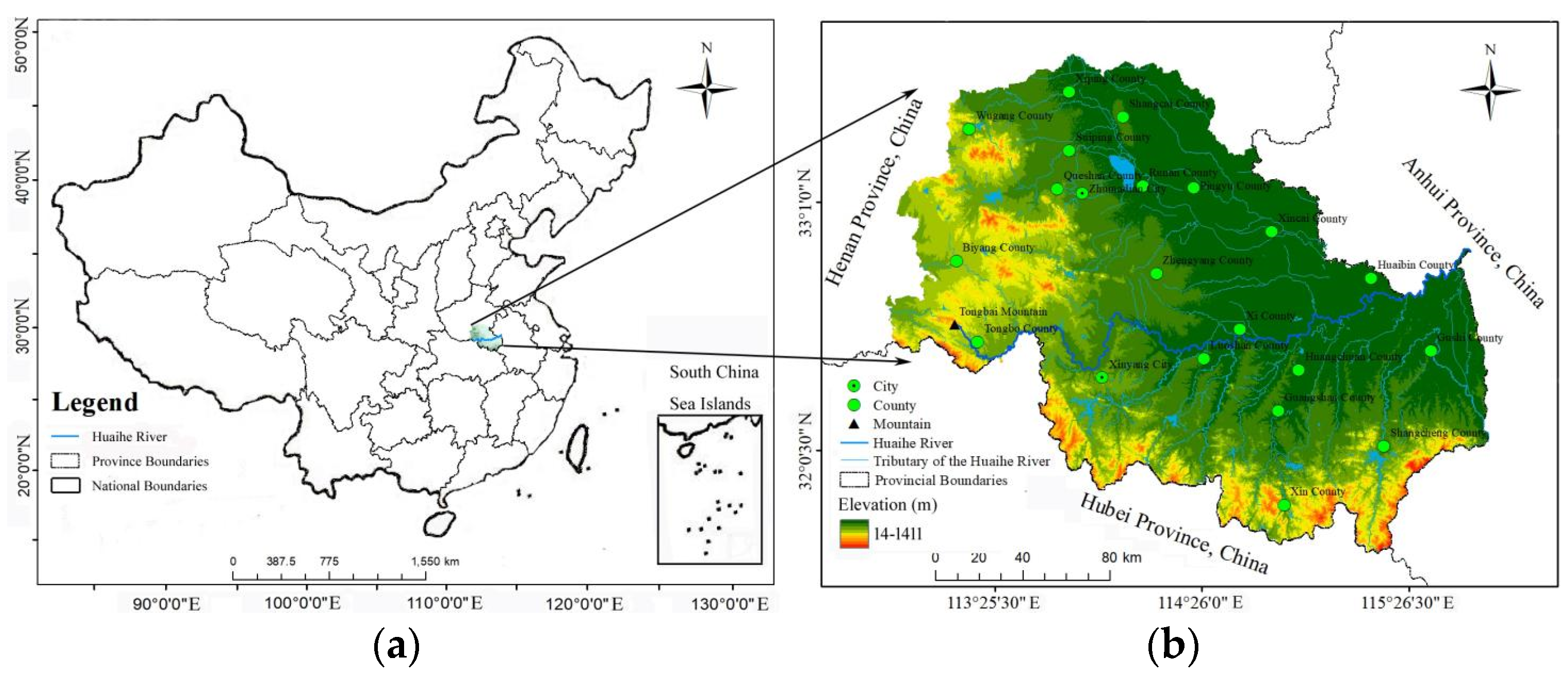


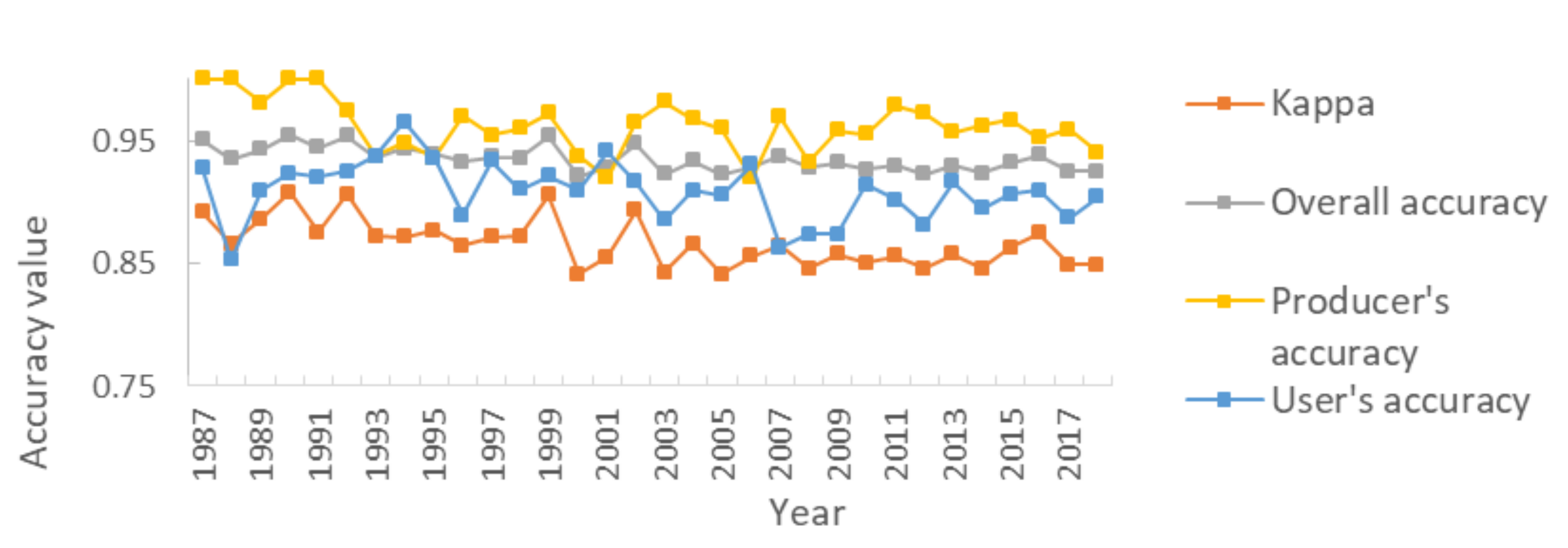
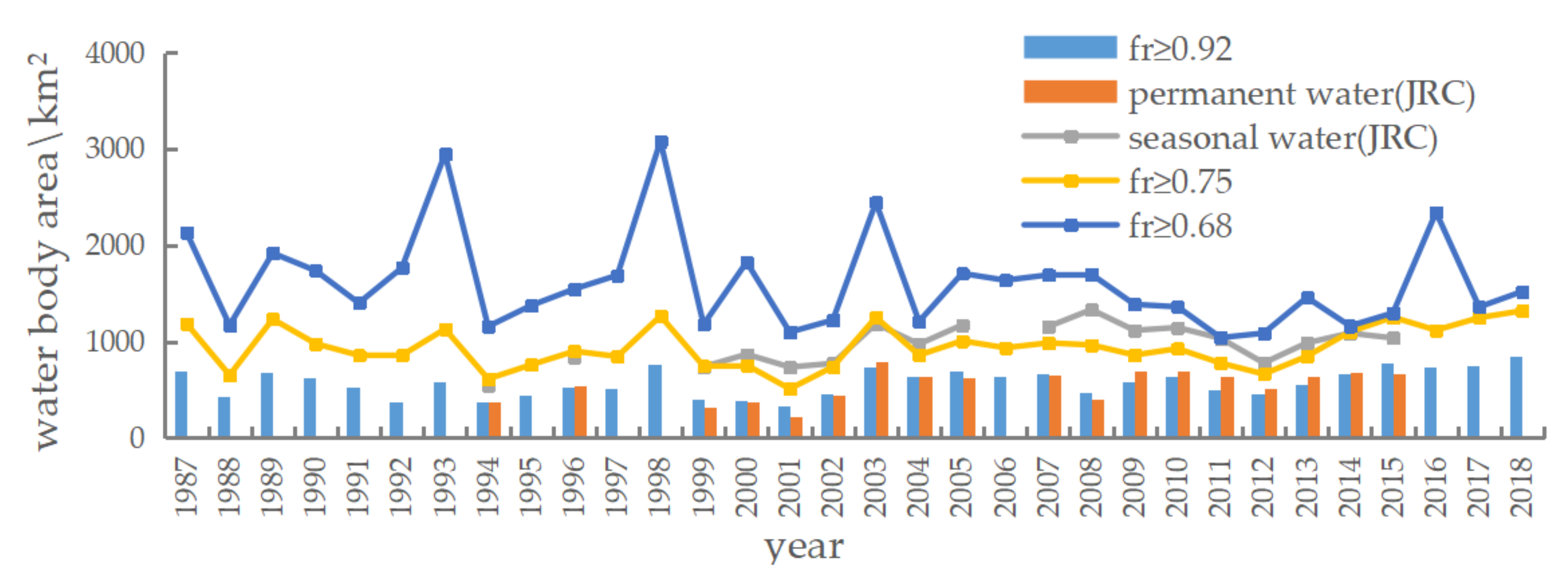
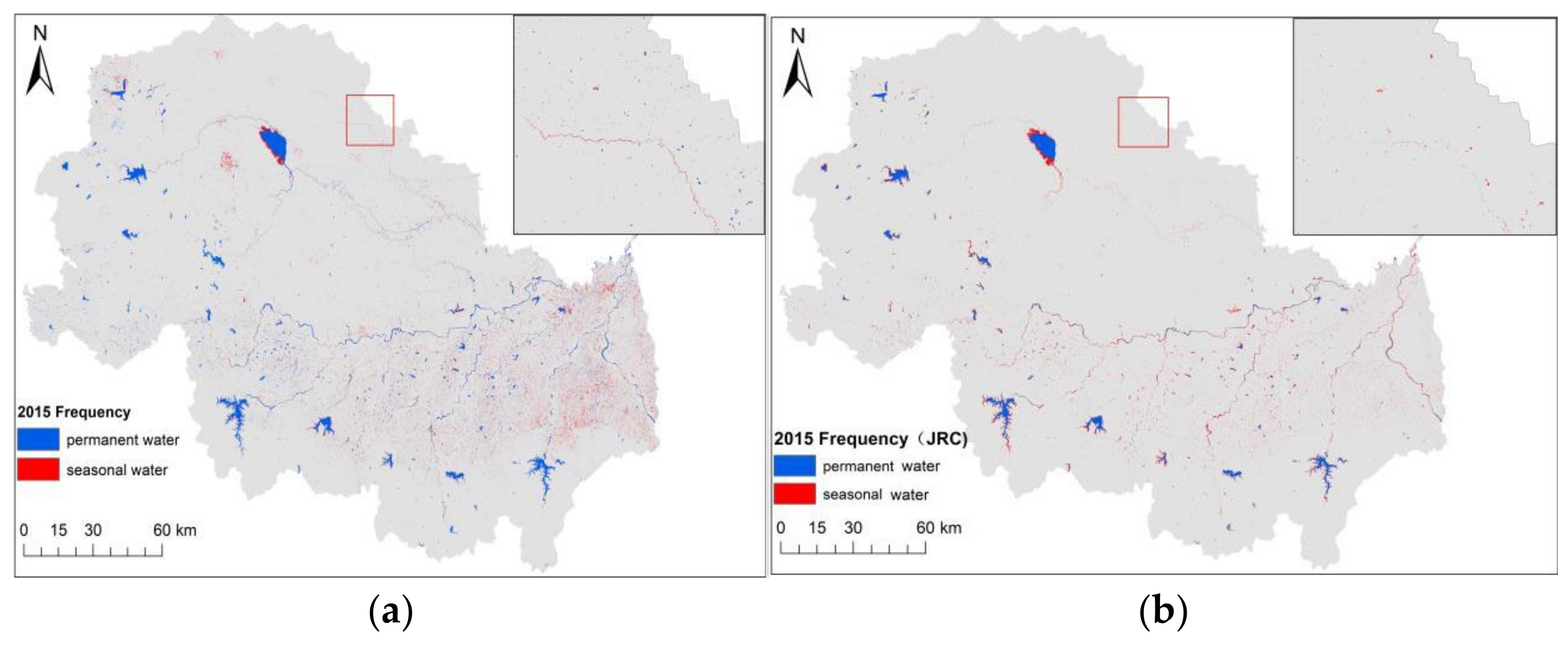


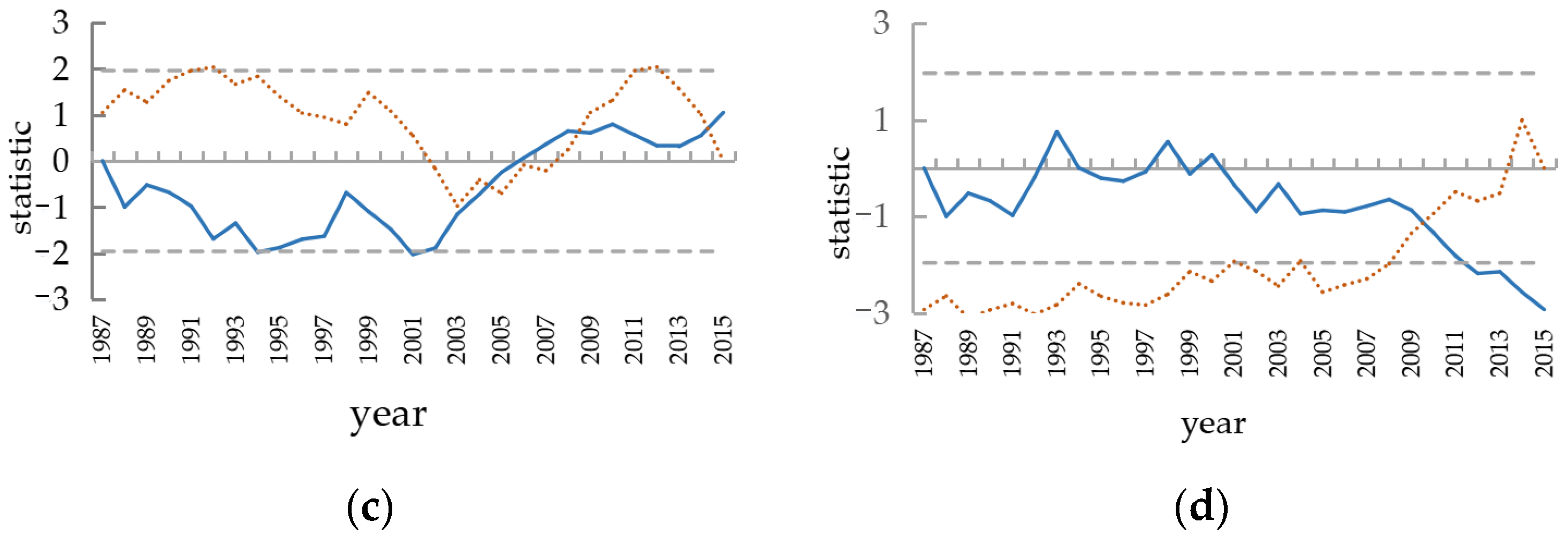
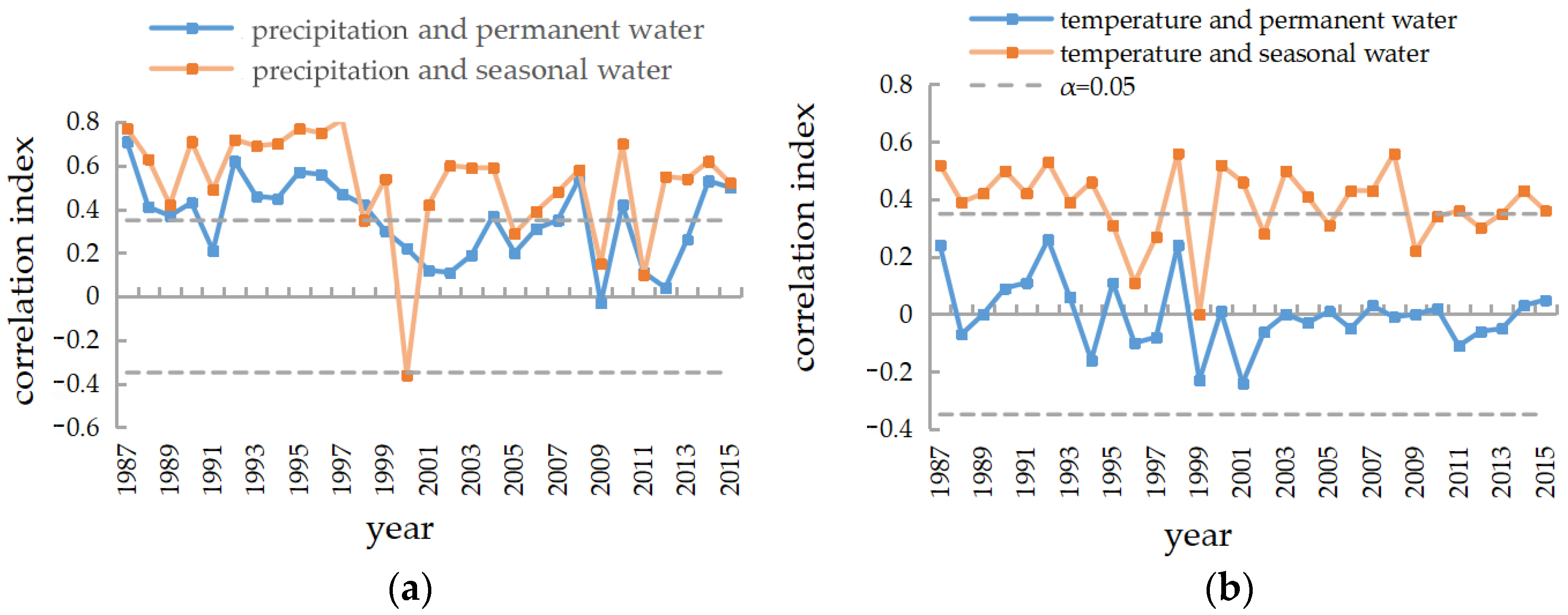

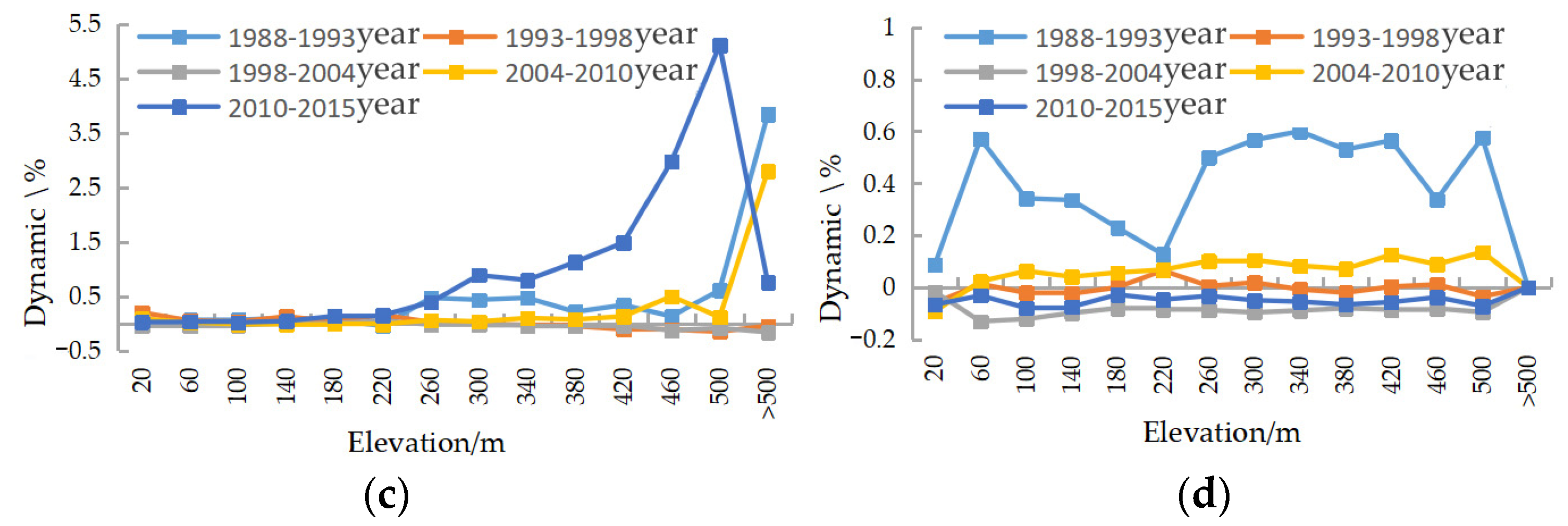
Publisher’s Note: MDPI stays neutral with regard to jurisdictional claims in published maps and institutional affiliations. |
© 2022 by the authors. Licensee MDPI, Basel, Switzerland. This article is an open access article distributed under the terms and conditions of the Creative Commons Attribution (CC BY) license (https://creativecommons.org/licenses/by/4.0/).
Share and Cite
Wang, H.; Liu, Z.; Zhu, J.; Chen, D.; Qin, F. Spatio-Temporal Extraction of Surface Waterbody and Its Response of Extreme Climate along the Upper Huaihe River. Sustainability 2022, 14, 3223. https://doi.org/10.3390/su14063223
Wang H, Liu Z, Zhu J, Chen D, Qin F. Spatio-Temporal Extraction of Surface Waterbody and Its Response of Extreme Climate along the Upper Huaihe River. Sustainability. 2022; 14(6):3223. https://doi.org/10.3390/su14063223
Chicago/Turabian StyleWang, Hang, Zhenzhen Liu, Jun Zhu, Danjie Chen, and Fen Qin. 2022. "Spatio-Temporal Extraction of Surface Waterbody and Its Response of Extreme Climate along the Upper Huaihe River" Sustainability 14, no. 6: 3223. https://doi.org/10.3390/su14063223
APA StyleWang, H., Liu, Z., Zhu, J., Chen, D., & Qin, F. (2022). Spatio-Temporal Extraction of Surface Waterbody and Its Response of Extreme Climate along the Upper Huaihe River. Sustainability, 14(6), 3223. https://doi.org/10.3390/su14063223





